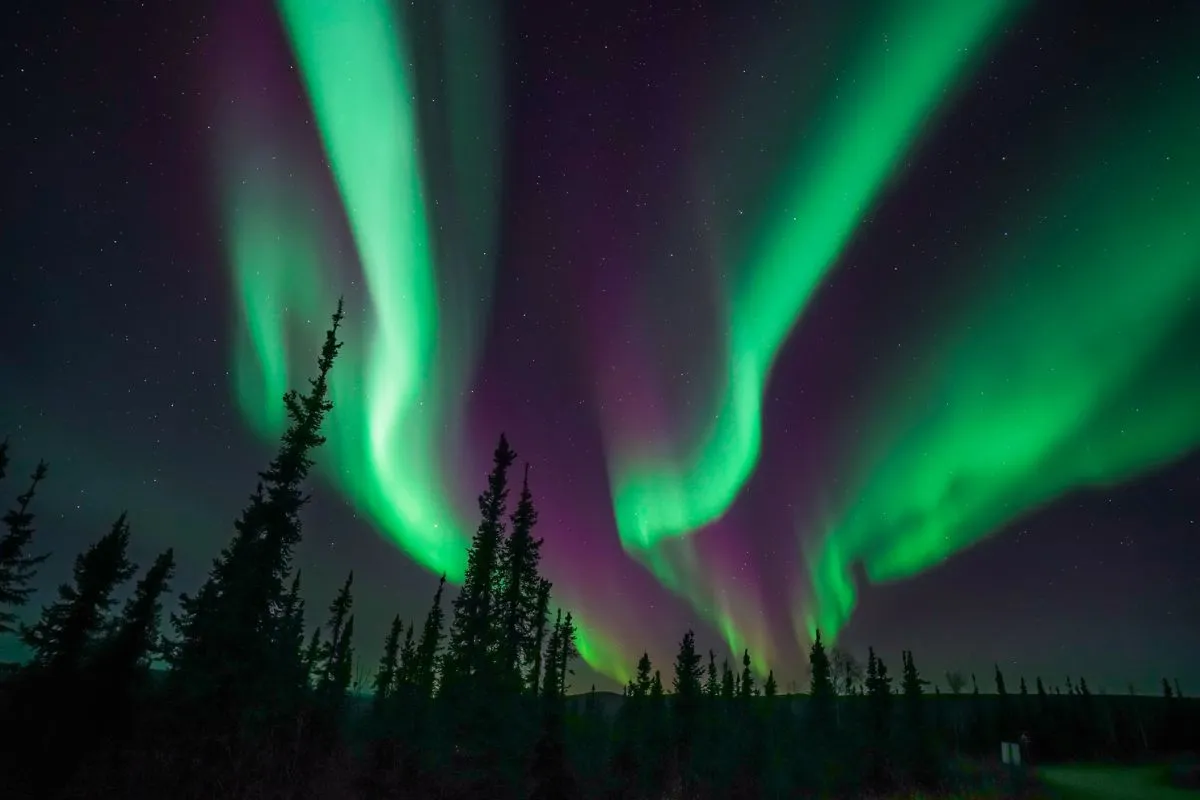Alaska is at its most beautiful between mid-June and mid-September. This is a particularly the best time to visit Alaska, with temperatures in the cool but comfortable range (15 to 19°C or 60 to 67°F). This time of the year you will experience milder weather and long days.
Throughout this time, bears, sea otters, seals, and whales can be seen, with June and July being the finest months for sightings.
Alaska’s weather can be harsh, especially the winter time. To prepare for the next winter, many excursions do, however, cease operations in early September. Winter is best avoided unless you want to participate in winter sports or see the northern lights under harsh conditions.
Here are some of the best seasons that will help you plan your Alaska trip wisely.
Best Time to Visit Alaska
High Season – May to September

Summer is the finest time of year to visit Alaska. The sun never sets in the far north, so you may hike well into the evening, and enjoy pleasantly warm temperatures. Furthermore, you can enjoy the state’s most captivating asset: its mesmerizing wildness, without having to worry about fierce blizzards, difficult terrain, or closed utilities.
Unsurprisingly, between May and September sees over 85% of Alaska’s annual tourists, most of whom travel there on cruise ships that sail during the warmer months.
The wildlife is busiest at this time of year. Everything is open, including ice cream shops and visitor centers for national parks.
Most trails are open by July, enormous bears congregate on riverbanks in response to migrating salmon, and fishing season is well underway.
Minor drawbacks include higher lodging fees and an occasional influx of day-trippers in tiny towns where cruise ships land.
Shoulder Season – April and October

The long sliver of land that divides British Columbia from Alaska’s panhandle has a warmer climate than the core of the state.
The months of April and October in this area are worth taking into consideration if you wish to engage in any early or late season outdoor activities.
Be prepared for a lot of rain and possibly even some snow, and keep in mind that many shops close up shop as the cruisers leave. You’ll therefore need to be more independent throughout the shoulder months.
Some smaller cruise ships begin voyages to southern Alaska in early April.
People Also Read: Best Time to Visit Galapagos Islands
Low Season – November to March

Winter is primarily for intrepid tourists.
Though largely local, skiing is a popular sport. The state’s little ski resorts don’t enjoy Aspen or Whistler’s fame on a global scale.
Dog Sledding and snowmobiling are two more winter sports that are available.
Winter is extremely gloomy and chilly. Cruise-ship-focused enterprises are shut this time of the year. Outdoor sports like kayaking and backcountry trekking are becoming challenging.
Snow makes wild animals less noticeable. The colossal Alaskan bears go into hibernation.
Despite this, there are not many positive aspects. This is the best time to visit Alaska to see Northern Lights thanks to its longer, darker nights, especially in the northern regions around Fairbanks. A few obscure festivals draw knowledgeable visitors.

Here’s the Month-by-Month Guide for Traveling in Alaska
January
Even though January is a bitterly cold month, it’s a special time of year to visit Alaska since you’ll get to see the state during its deepest winter.
Due to its proximity to the Arctic Circle, Alaska’s extreme north experiences almost no daylight in January. But if you stay south in Anchorage or Juneau, you can take advantage of a few hours of sunlight each day.
In fact, January is the perfect time to visit for flightseeing journeys over the glaciers and mountains. This is the time of the year when the skies are so gorgeously pure and the sun shines for its brief period each day.
As you travel further north, your chances of seeing the Northern Lights at night increase.
Key events – Snow sports, like dog sledding and snowshoeing, are widely available. The long winter months are also a great time to discover the local traditions.
February

Depending on the weather, it may be even colder and darker in February than it was in January.
The weather will be extremely unpredictable, and it is not the ideal time to travel to Alaska because of the near-constant darkness.
If the skies are clear, you can still go on the occasional flightseeing excursion. Naturally, this is an excellent time to observe the Northern Lights.
If you venture outside of the cities, you may be able to see the Northern Lights in the sky. You can also enjoy dog sledding or snowshoeing.
Key events – Yukon Quest (Fairbanks), and Cordova Ice-worm festival.
March
While March marks the start of Spring in the southern United States, it’s a very different story in Alaska.
Even though it’s still winter, the days are getting lighter and warmer as we go towards March.
The days are getting longer, so now is a fantastic time to visit if you want to enjoy outdoor activities in Alaska’s national parks.
In fact, this could be the perfect time to travel to Alaska if you want to see the Northern Lights.
Key events – The Iditarod dog sledding race, one of Alaska’s most important events, takes place in March.
April

The change from winter to summer weather starts in April. This is the short Alaskan springtime, and it’s the best time to visit Alaska before the summer tourists arrive.
While it is considerably easier to go overland, a small number of cruise ships begin to arrive in areas like Anchorage or Juneau.
When you visit the national parks, you’ll start to see all kinds of creatures, including moose and perhaps even the white bear, as they start to come out of hibernation.
Key events – Alaska Folk Festival (Juneau)
May
May marks the beginning of summer, or at the very least the end of spring, as temperatures continue to rise throughout the month.
Now that winter has arrived, the days are wonderfully long and will only become longer as you move farther north.
Whales will start to appear in the ocean, and the number of animals in the national parks will increase.
Alaska is in full bloom in May, and fortunately, it’s still very much the shoulder season because the summer tourists haven’t yet descended upon the ports.
June

Since June marks the beginning of the peak season, this is actually the month when the summer throngs first start to show up.
If you want the most visited locations, like Denali National Park or the well-known glaciers in Juneau or Anchorage, to yourself, now is not the time to travel to Alaska.
But keep in mind that Alaska is a huge place, and there is much more to see than simply the popular tourist destinations.
If you take the time to get north, you’ll immediately notice that the cruise crowds thin out and you’ll have the wilderness to yourself.
Go to Fairbanks, the Kenai Peninsula, or, even better, travel extremely far north to the Arctic Circle, where the sun never sets.
Travel to Fairbanks or the Kenai Peninsula, or even further north for the Midnight Sun in the Arctic Circle, where the sun never sets for most of June.
July
Big brown bears are drawn to rivers in iconic locations like Kodiak Island and Katmai National Park by active salmon flows. The days are long, the weather is warm, and the spirits are high.
July is still the peak season, and the state is still in the midst of summer. This is the best time to visit Alaska if you want to hike and explore the national parks.
All of the national parks are now fully accessible since the majority of the snow has melted. If mountaineering is your preferred activity, you can enjoy hiking around Denali National Park.
In July, there is little nighttime darkness, long days, and abundant animals on both land and in the sea.
Take a trip to the lesser-known Aleutian Islands, which are beautiful at this time of year, for a unique experience.
Key events – Mt Marathon Race (Seward), World Eskimo-Indian Olympics (Fairbanks).
August

The days continue to cool significantly in August. There is still plenty of daylight, with sunshine averaging roughly 18 hours per day across the state.
The wildlife is on the display enjoying the weather before the brief autumn arrives. Alaska is plunged into darkness as winter approaches all too soon.
August sees the last of the summer crowds, but towards the end of the month, things are quieter.
Key events – While the waters off the coast will be swarming with humpback whales and orcas, this is a terrific last chance to explore the top national parks and outdoor activities in Alaska.
September
The lovely summer weather is already gone by September, but it is preceded by a glorious autumn hue all around the state.
The best time to travel to Alaska to experience the wildlife. The Brown Bears prep up for their winter hibernation by loading up on food.
If you travel up north and are lucky, you could also get to view the Northern Lights.
The nights are becoming longer. There is still plenty of daylight, and there are no summer crowds.
Key events – Seward Music & Arts Festival
October

The days are getting much shorter and the nights are getting much longer by October, signaling that winter is almost here in Alaska.
As wildlife gets ready for the winter season, they start to settle in the deep wild and become more difficult to spot.
Since it is primarily the shoulder season, there aren’t many other travelers in the area.
Unfortunately, not only is this a transitional month for the weather, but also for tourism activity.
Many summer activities, such as hiking, are now difficult, and there hasn’t been much snowfall, so winter activities have yet to begin.
All of this ensures that October isn’t many vacationers’ first choice and really isn’t the best time to travel.
Key events – Alaska Day Festival
November
Winter officially begins in November, and the state begins to receive significant snowfall.
The days are now much shorter and it gets very cold, especially at night.
Snowshoeing and dog sledding are both enjoyable winter pastimes. You’ll have a good chance of viewing the Northern Lights.
December

December is a dark month in Alaska. But if you’re looking for a true winter break with a guaranteed white Christmas, this would be an interesting trip.
To capture the unique splendor of an Alaskan winter, grab a camera, some thick gear, and a snowmobile. Due to the brighter skies, it could be possible to see Denali’s ice-crusted face more clearly than during the summer.
Be ready for the cold, but also be ready for the unusual winter experiences. Instead of traveling too far north, stay in the south for better weather and a higher likelihood of viewing the Northern Lights.
When are You Planning Your Trip to Alaska?
In summary, if you have never been to Alaska, and you do get a chance to visit the state, I would suggest that you pick from one of the months outlined above. The prices will be competitive, the weather will be mild, the attractions will be wonderful and in abundance, and you can enjoy yourself without any problems.




